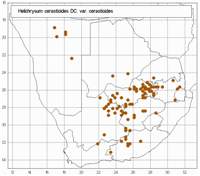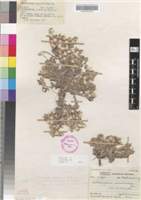Common names:
Wolbossie (A)
Origin of name:
cerastoides = resembling Cerastium (genus name from the Greek keras (horn)); referring to the shape of the seed capsule
Diagnostic characters:
Bract tips white, sometimes tinged pinkMedium-sized solitary headsSmall, densely branched shrublets with lots of leavesVery showy plantsOften woolly-hairy
Description:
Bushy herb, taproot woody, main branches up to c. 200 mm, erect, decumbent or prostrate, simple or branched, grey-woolly, closely leafy throughout. Leaves 5-20 x 1-4 mm, scarcely decreasing in size upwards, often patent, linear, linear-lanceolate, oblanceolate or oblong, obtuse to acute, margins more or less revolute, base broad, half-clasping, shortly decurrent, both surfaces grey-woolly. Heads heterogamous, campanulate, c. 7-10 x 6-10 mm, solitary or few clustered at the tips of very short side branches at the tips of the main branches, surrounded by leaves webbed together with wool. Involucral bracts in c. 6 series, subequal, loosely imbricate, exceeding flowers, acute to acuminate, white, pellucid and glossy below, tips white sometimes tinged rose, subopaque, radiating, outermost sometimes tinged pale golden-brown. Receptacle shortly honeycombed. Flowers 41-172, 10-36 female, 36-136 homogamous, yellow, tipped pink. Achenes 0.75 mm long, with myxogenic duplex hairs. Pappus bristles many, equaling corolla, scabrid, bases with patent cilia, not cohering.
Flowering mainly between June and October.
Distribution:
Favours open flats and slopes on sand, gritty quartzites or calcareous soils; often behaves as a weed. Widespread in central southern Africa from NE. Namibia through Botswana to Zimbabwe, the arid NE. Cape (E of 22�E), the Gauteng and Mpumalanga Highveld, the dry western Free State and the E. central Cape from Victoria West to Cradock and Queenstown.
Savanna, Grassland and Fynbos Biomes.
Notes:
Over the eastern part of the range, specimens resemble the type of H. obvallatum and have large heads (both in overall size and in the number of flowers in a head) and large leaves with margins scarcely revolute. North-westwards, from the N. central Cape to Zimbabwe, Botswana and Namibia, both heads and leaves tend to become smaller, and the leaves are more spreading with margins more strongly revolute. The types of both H. cerastioides and var. gracile match this form. In Namibia, H. cerastioides is sometimes confused with pale-headed specimens of H. pumilio subsp. fleckii, but the narrow, more or less linear, patent leaves of H. cerastioides in this region tend to give it a characteristic facies. Also H. cerastioides grows on the flats, while H. pumilio subsp. fleckii is on the mountains. However, var. aurosicum is problematical.
Two varieties are recognized:
(a) var. cerastioides (b) var. aurosicum
Taxonomy:
Literature:
Helichrysum cerastioides DC., Prodr. 6: 171 (1838); Harv. in F.C. 3: 216 (1865); Moeser in Bot. Jb. 44: 302 (1910); Merxm., F.S.W.A. 139: 93 (1967).
Type:
Lectotype: Cape, beyond the Gariep [Orange], not far from Litakun, Burchell 2225�1 (G-DC; K, isolecto.).
Synonym(s):
Gnaphalium cerastioides (DC.) Sch. Bip., in Bot. Ztg 3:169 (1845).
Helichrysum obvallatum DC., Prodr. 6: 174 (1838); Harv. in F.C. 3: 222 (1865). Gnaphalium obvallatum (DC.) Sch. Bip. in Bot. Ztg 3: 169 (1845). Lectotype: Cape, Queenstown distr., Klipplaat River, Shiloh, Nov., Dr�ge 5809 (G-DC; BM, isolecto.).
H. cerastioides var. gracile Moeser, l.c. Lectotype: Namibia Grootfontein, Dinter 666 (Z).
H. gracile [Moeser ex] Dinter in Fedde, Repert. 18: 249 (1922), nomen.
Vouchers:
Acocks 11720 (PRE); Dinter 7671 (M; PRE; WIND); Flanagan 1422 (NBG; PRE); Leach & Bayliss 12975 (M; PRE; WIND); Tyson 261 (SAM).


_sml.jpg)
_sml.jpg)
_sml.jpg)
_sml.jpg)
_sml.jpg)
